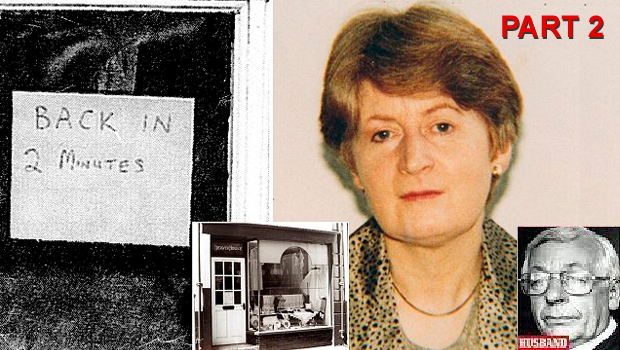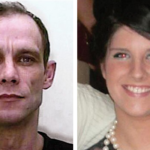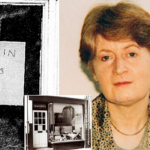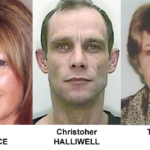The Operation Blue CORAL Fiasco (2)
by TIM HICKS and CHRIS CLARK
~~~~~
For some time now, both authors have been investigating the murder of Mrs Trevaline Evans in Llangollen, North Wales in June 1990. They have concluded that Trevaline could have been abducted and murdered by serial killer Christopher Halliwell, who they also believe is also responsible for the murder of Claudia Lawrence, who was abducted from York in 2009.
Halliwell is currently in prison on a full life sentence for the 2003 murder of Becky Godden-Edwards and the 2011 murder of Sian O’Callaghan.
Following on from their article Halliwell: The North West Clusters, in which the authors analysed a series of murders in the North West of England and linked Trevaline’s murder to them.
This is the second part of an article where the authors analyse the various investigations that have taken place into Trevaline’s murder and the reasons they failed.
The first part can be accessed here and should ideally be read before proceeding further with this article.
The NYE has taken up this case because Trevaline’s siblings and her son are all now dead and there is no one to uphold her right to justice with North Wales Police (NWP), and because the Trevaline Evans case leads into the author’s analysis of the failings in the Claudia Lawrence investigation.
Operation Blue CORAL: 2010 Investigation
The case was re-opened, but no progress was made. Again, the FMIT did not interview the two witnesses who saw the man behaving suspiciously near Trevaline’s shop (Major Investigative Failure (MIF23 and MIF24), or try to trace the van (MIF25). Indicating that all the information had not been entered into HOLMES, or that HOLMES was ignored (MIF26).
To put the impact of not using Holmes in context, it is necessary to consider the case of Suzy Lamplugh, who disappeared in Fulham, London in 1986. HOLMES was not available at the time and the investigation failed.
In 2010, it was re-opened for a cold case review. The 2010 investigation started by putting everything onto HOLMES, which identified that there had been a series of attempted abductions in Fulham, which in turn led the investigation to serial killer John Cannan.
Had HOLMES been properly utilised by NWP in 1990, the authors believe that it would have significantly improved the investigation, ensured that these and other witnesses were followed up, possibly leading to a resolution of the case.
Operation Blue CORAL: 2011 Investigation
This investigation was limited to considering the serial killer Robin Ligus as a suspect and correctly excluded him.
Operation Mayan and the 2011 antecedent Investigation
In 2011, Christopher Halliwell was arrested for the murder of Sian O’Callaghan and Becky Godden-Edwards. Details of Halliwell, his lifestyle and his modus operandi were circulated to all forces by Wiltshire Police’s Operation Mayan. This was accompanied by his photograph, information on his modus operandi and a request that they consider if he could have committed any murders in their force area.
This should have triggered great interest from NWP. Trevaline disappeared on a weekend during the summer holiday tourist season and Halliwell had many reasons to come to Llangollen:
- Halliwell was known to enjoy narrow boating. The Llangollen Canal connects to the Shropshire Union Canal and then into the English Canal system. Trevaline’s route from home to her shop would have taken her past the road and bridge over the River Dee that led to the Canal Basin, which is 5 minutes’ walk from the shop.
- Halliwell was known to enjoy fishing and the River Dee has excellent fishing.
- Halliwell’s itinerant lifestyle could have brought him to Llangollen. It is one hour twenty minutes’ drive from Aughton Park and three and a half hours drive from Swindon. If he was working in North Wales, he could have stayed over for the weekend to go sightseeing.
- There were unconfirmed sightings of Trevaline near the River Dee at about 14.35 and then another a few minutes later of her walking along a footpath away from the River. Was she discretely meeting someone away from the shop while he was fishing at the River Dee. Was that man Halliwell?
[See Map, here]
Trevaline’s murder also fitted perfectly with Halliwell’s modus operandi.
- In the period 1982 – 1985 Halliwell had several jobs and used them to reconnoitre houses to burglarise them for antiques. He may have picked up a working knowledge of antiques from these crimes. Although he had no similar convictions after his release from prison, this does not mean that he had reformed and stopped committing burglaries. It may be that he was still burglarising houses for antiques, but was not detected. Trevaline had a sign in the shop saying she would buy and sell anything. This would give Halliwell a reason to visit the shop to sell stolen antiques. The authors suspect that Trevaline had a large amount of cash on her because she intended to meet someone to pay for antiques. This may have been Halliwell. Chris remembers:
“Antique theft is a specialist crime and a key aspect of it is disposing of the stolen property. This generally has to be done through a fence, or by travelling long distances to sell off the stolen property to legitimate dealers. As an example, in Norfolk, we had a serious problem with a gang from Brighton going door to door purporting to buy and sell antiques, then returning a few days later to burgle those houses they had identified knowing that it would not be traced back to crimes committed as far away as Norfolk.
In the 1970’s I investigated a series of brace and bit burglaries in Kings Lynn, Norfolk. They transpired to have been committed by the notorious Donald Nielson, also known as “The Black Panther”. As well as being an armed robber and kidnapper, was a prolific burglar, committing hundreds of burglaries from 1965 onwards, varying his modus operandi and operating far from his home in Bradford. He was only identified as the burglar after his arrest in 1975.
I therefore find it credible that Halliwell could have still been committing burglaries to steal antiques and sell on after his release from Dartmoor in 1987 and was not detected. Particularly if he was fencing the items he had taken far away from the area he stole them from.
Having been convicted of burglary involving antiques in Wiltshire and the surrounding area, Halliwell will have realised that if there were any burglaries in that area, he would very quickly become a prime suspect, resulting in his house being searched, inevitably leading to his arrest and a return to HMP Dartmoor. This would have discouraged him from returning to burglary in Wiltshire and would have forced him to commit burglaries much further away from his normal operating area.
I therefore consider it possible that Halliwell could have been in Wales to sell antiques he had stolen in a different part of the country. He may also have been in Wales to burgle premises that had antiques in them, while he was on holiday or working there.”
- Trevaline’s credit cards were left untouched. Credit Card fraud is a separate form of theft, requiring a different skill set to pull it off successfully. Halliwell has no history of credit card fraud, indicating that he would be unlikely to steal credit cards, for fear of being detected when he used them.
- Trevaline’s body has never been found which is consistent with Halliwell’s modus operandi. We know from the murder of Becky Godden-Edwards that he was very skilful at sighting a grave in a rural area, where it would not be discovered. A local witness saw a man with a van, who resembled Halliwell behaving suspiciously outside Trevaline’s shop and at a local beauty spot –Horseshoe Pass- that was remote and on a hill, so it would be easy to roll a body down the slope and then conceal it. Exactly as Halliwell did to Sian O’Callaghan’s body.
- Trevaline was skilfully and efficiently abducted in daylight in Llangollen without anyone witnessing a struggle or any of her possessions found at the scene. This would point towards abduction by persuasion -not force- by a practised abductor. This is consistent with Halliwell’s abductions of Becky Godden-Edwards and Sian O’Callaghan. When he was a taxi driver Halliwell had a reputation for being well spoken, charming and persuasive with passengers. He was certainly capable of striking up a conversation with a woman and persuading her to get in a car with him on a pretext of giving her a lift, or taking her to view some antiques.
- Trevaline’s clothes were never found. It is therefore possible that some items were taken as a trophy, which is a classic Halliwell indicator. Perhaps some of her clothing was recovered from Halliwell’s trophy cache in a lake at Ramsbury, Wiltshire where he went fishing.
- Trevaline looked like Sian O’Callaghan and Claudia Lawrence, who in turn had a resemblance to Halliwell’s mother, who he hated. Just the sight of a woman who reminded him of his mother threw Halliwell into a rage. She therefore fitted Halliwell’s victim preferences.
This all indicates Halliwell as a good suspect whose modus operandi fitted the murder of Trevaline Evans.
However, he was ignored by the FMIT (MIF27), which failed to re-interview either witness that saw the man outside the shop and show him a photograph of Halliwell, to see if it was Halliwell (MIF28 and MIF29). The authors believe that this was because the FMIT was affected by confirmatory bias and obsessively focussed on Richard Evans as a suspect to the exclusion of all other suspects (MIF30).
This illustrates the importance of cold case investigations being impartially reviewed. Because FMIT conducted both the initial investigation and the cold case investigation, the case has never been reviewed independently (MIF31).
Operation Kala 2022: Independent Office of Police Conduct (IOPC) investigation into the Wiltshire Police investigation into the murder of Becky Godden-Edwards Operation Manilla between 2011 and 2014
Bedfordshire/Cambridgeshire/Hertfordshire Police Professional Standards Department investigated the Wiltshire Police investigation into the murder of Becky Godden-Edwards from 2011 until 2014, on behalf of the IOPC, which was codenamed Operation Manilla.
Operation Kala found that significant opportunities to convict Halliwell -who had been convicted for the murder of Sian O’Callaghan- for the murder of Becky Godden-Edwards were missed during a flawed investigation, (report here) for which the then Detective Chief Superintendent Kier Pritchard had responsibility.
This indicates that the antecedent investigation was not properly managed and coordinated across all forces by Wiltshire Police, which ensured that NWPs FMIT was not subject to any external scrutiny (MIF32).
Operation Blue CORAL: 2019 investigation
In 2019, FMIT searched under the bar of the Rhuddlan Golf Club Clubhouse looking for Trevaline’s body. Article from North Wales Live with more information here.
This would indicate that FMIT was still following the theory that Richard Evans had murdered Trevaline and disposed of her body in Rhuddlan. Nothing was found.
Maps by FAD
Coming next: The Operation Blue CORAL Fiasco (Pt.3)
Appeal for Information
Did you see Christopher Halliwell:
- Fishing along the River Dee?
- In Llangollen
- Fishing at Scarborough?
- Fishing at Whitby?
- Fishing along the River Tees?
- Fishing at Scaling Dam?
- In York driving a red rover?
- At Ampleforth?
- At Oswaldkirk?
- In Middlesbrough?
- In Huddersfield?
- In Merseyside driving a white D Reg van?
- At Aughton Park?
- In Manchester?
- In Sheffield?
- Did he drive you from Swindon to Sheffield or York University?
Please email letters@nyenquirer.uk. All enquiries will be treated in the strictest confidence.



























Comments are closed.